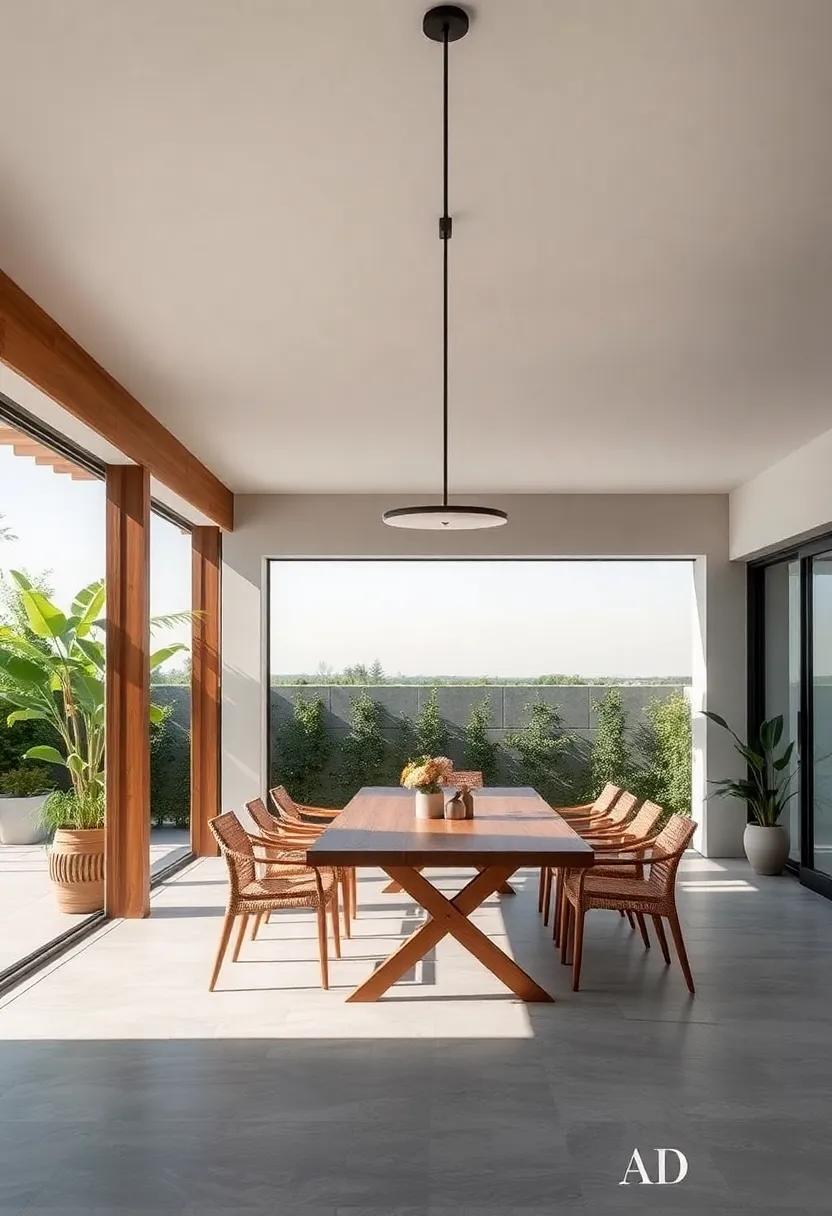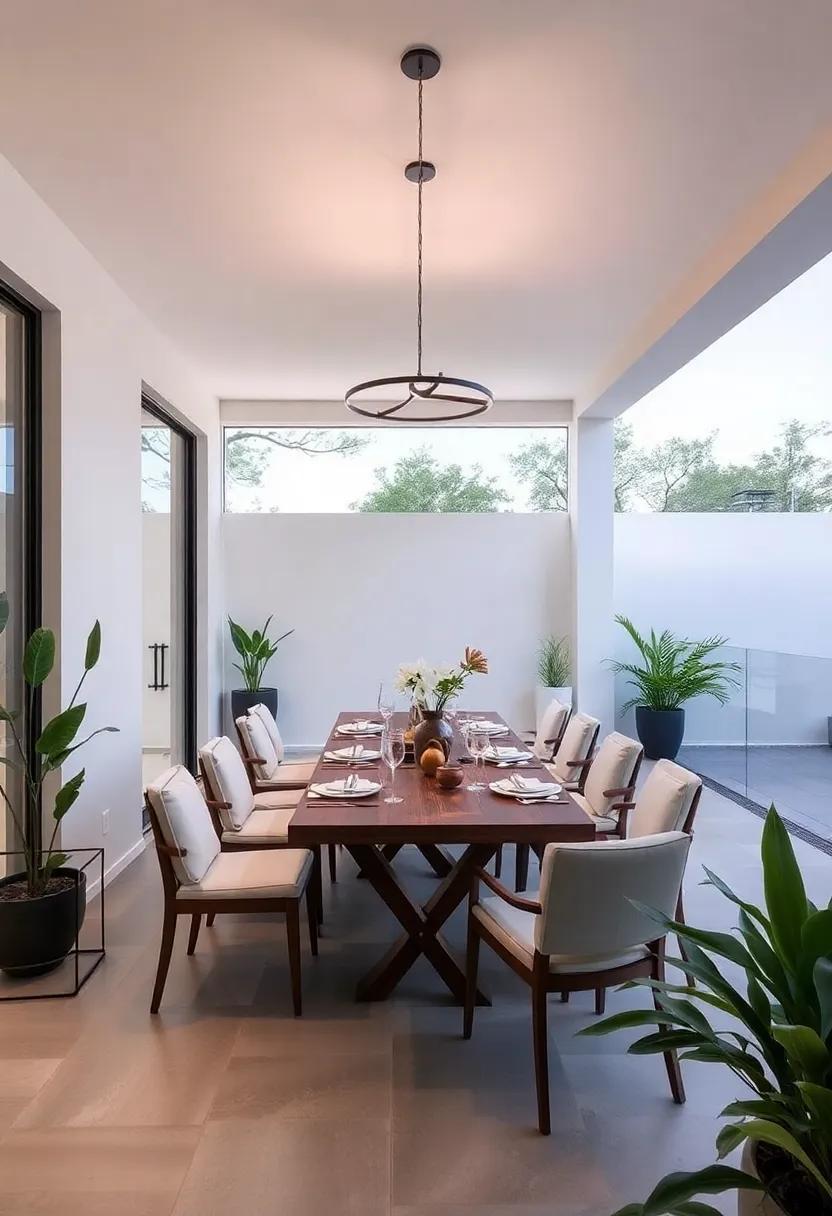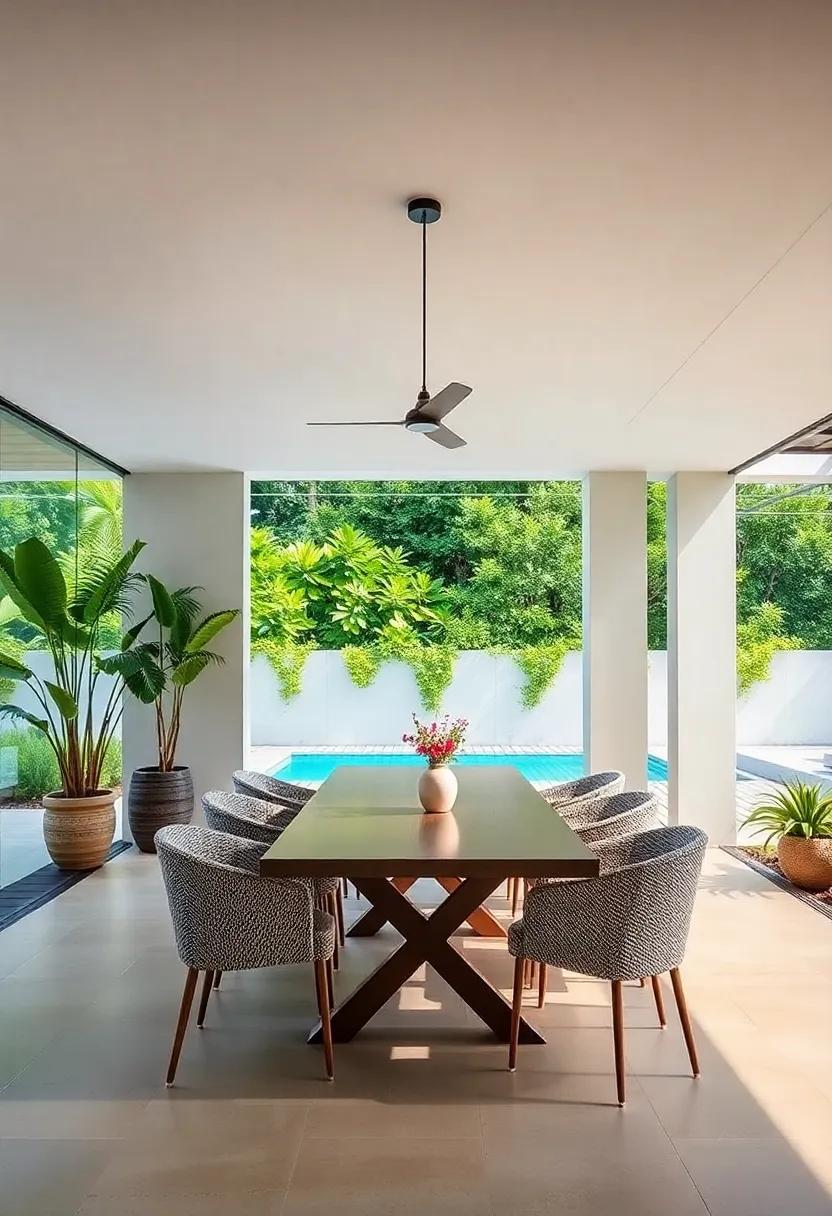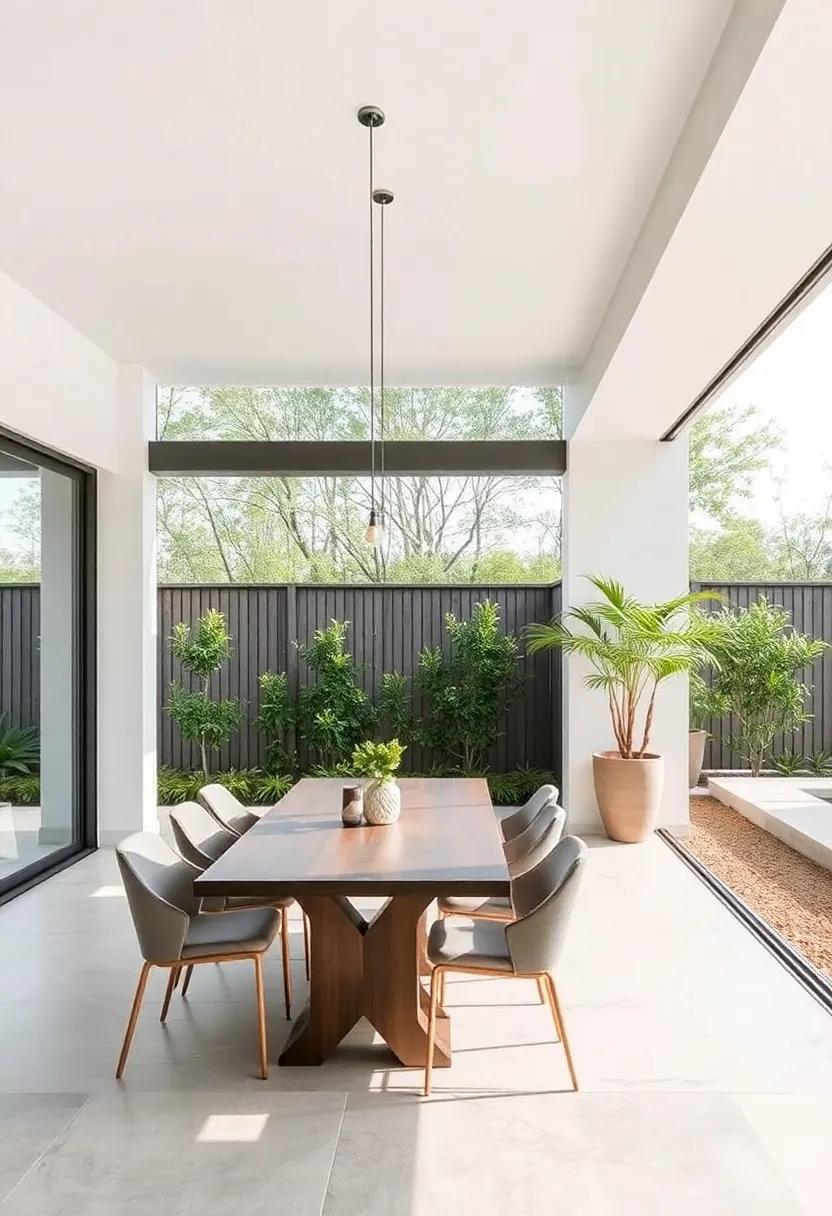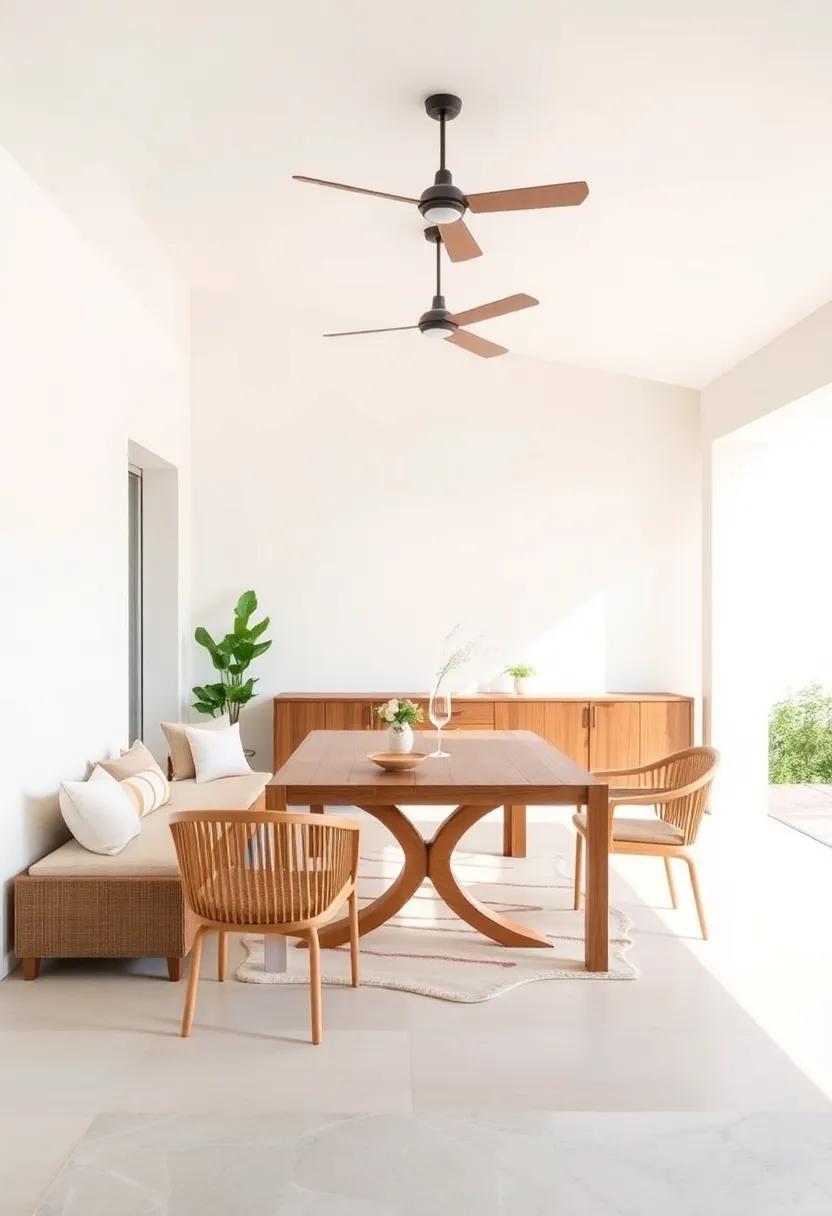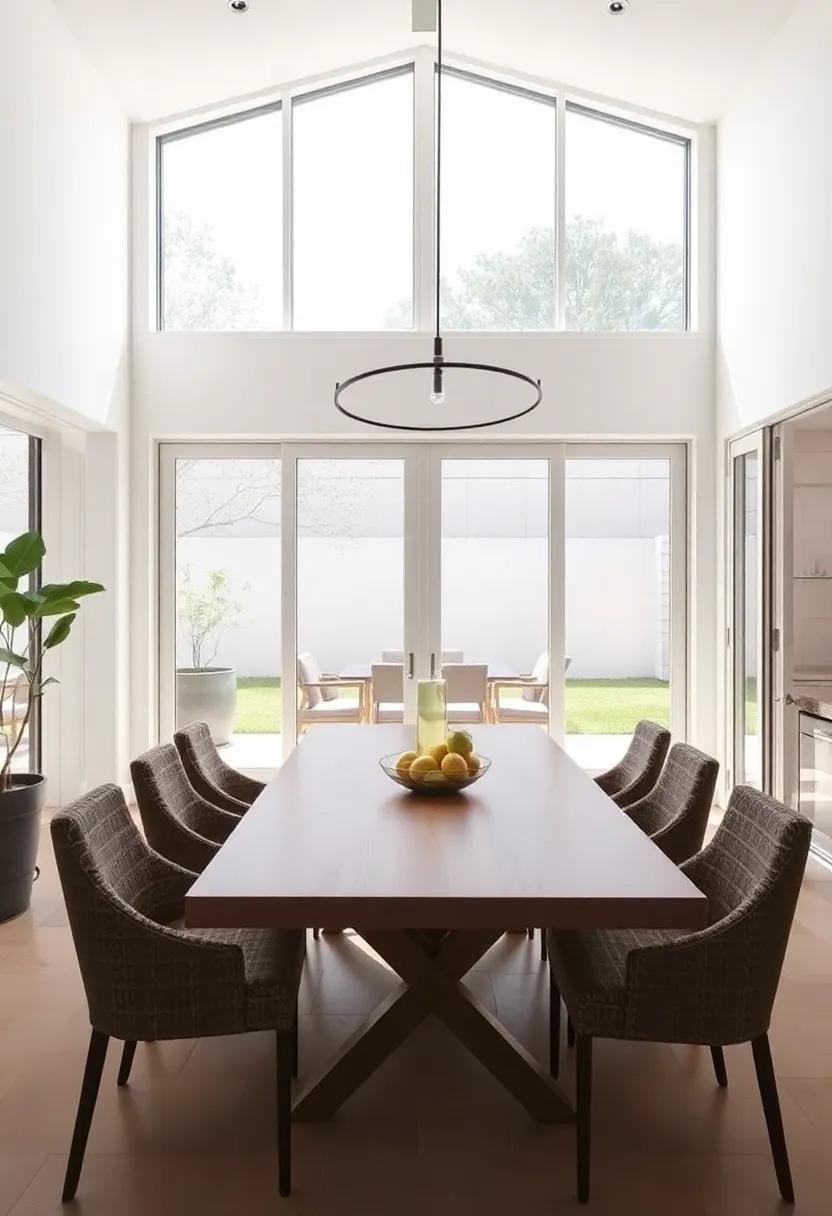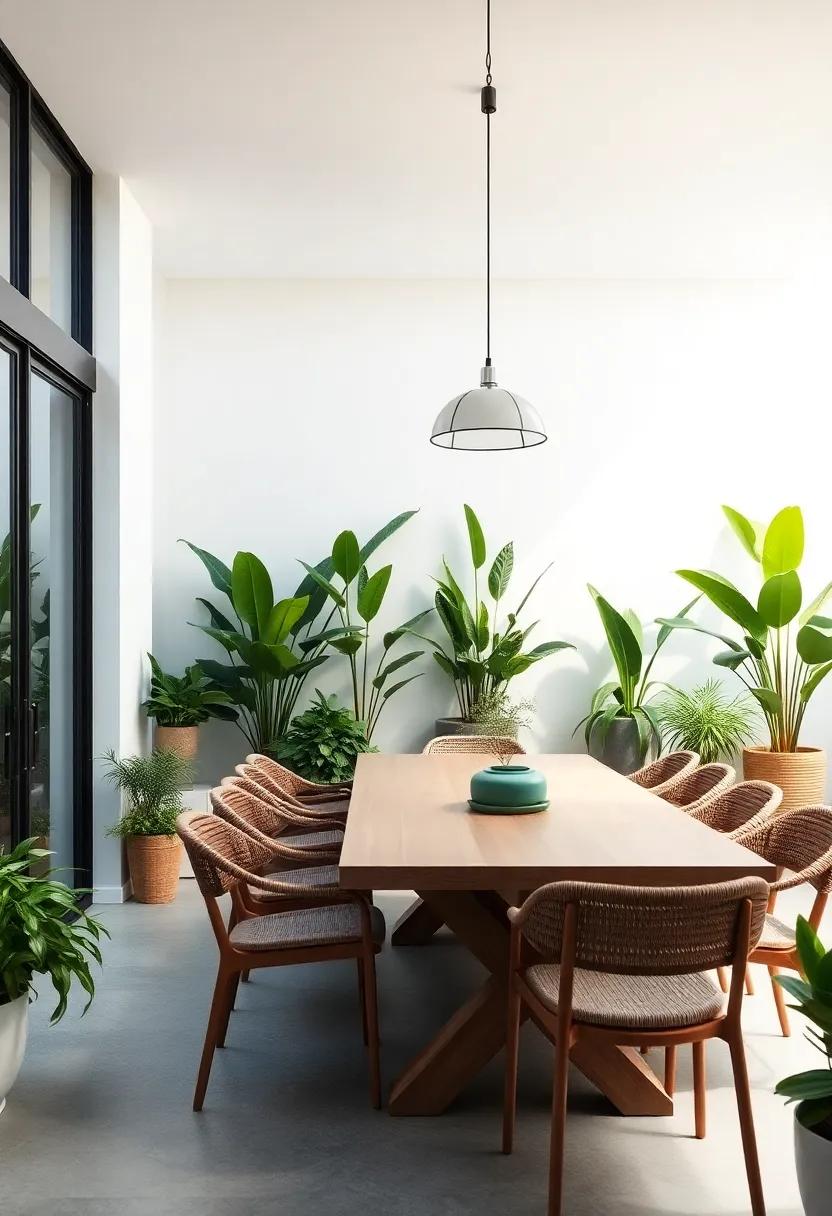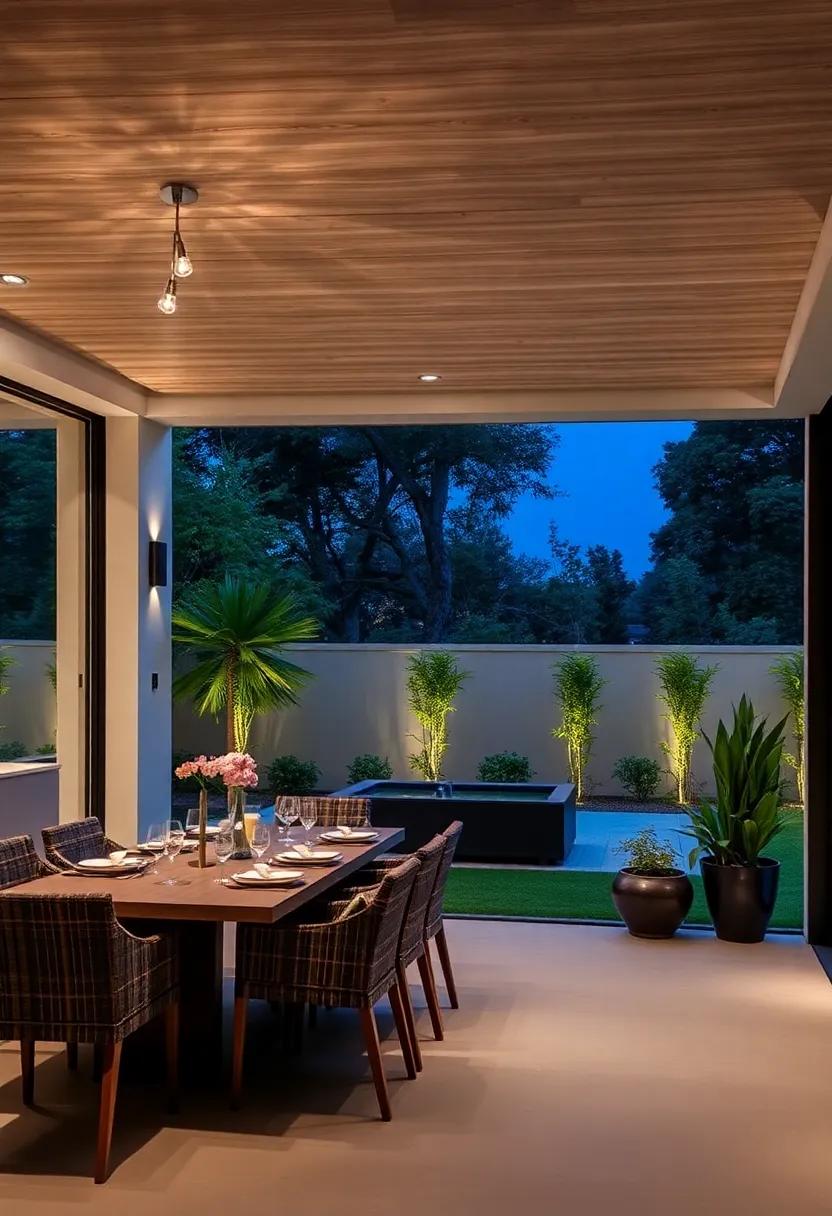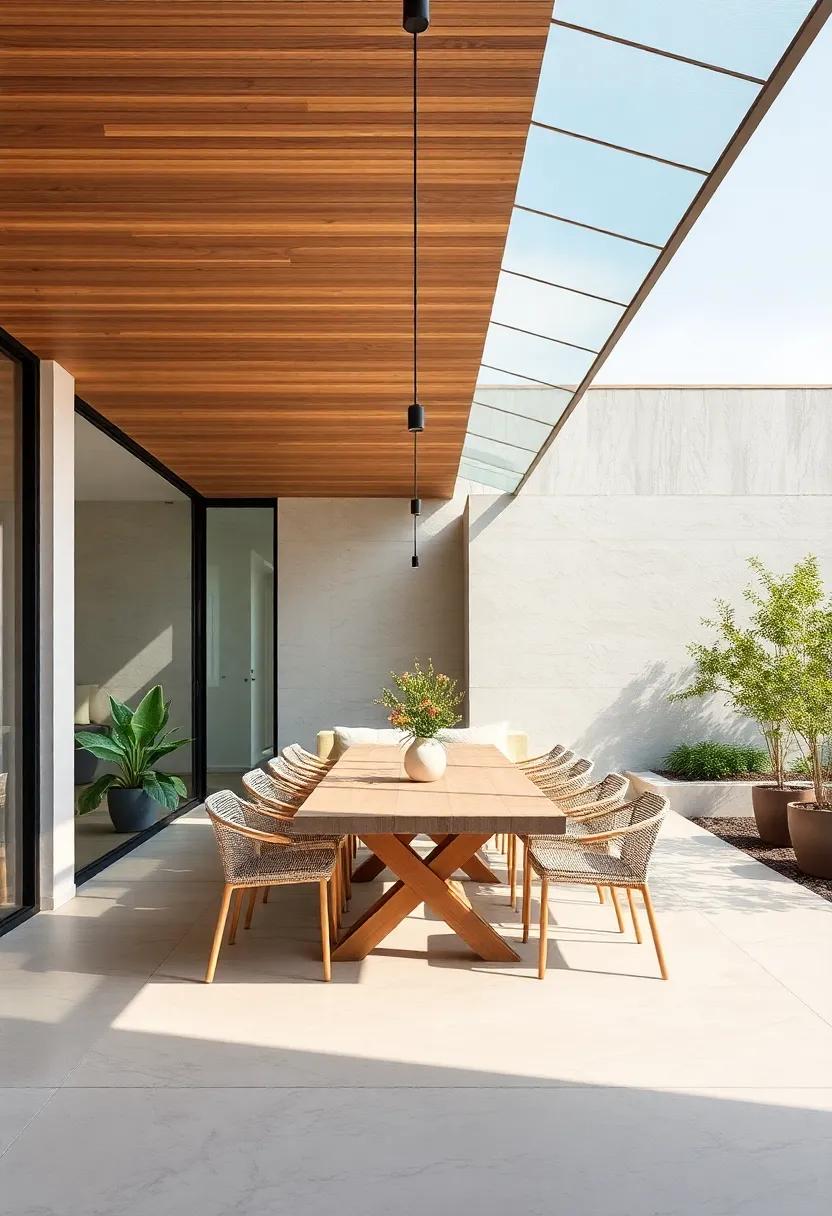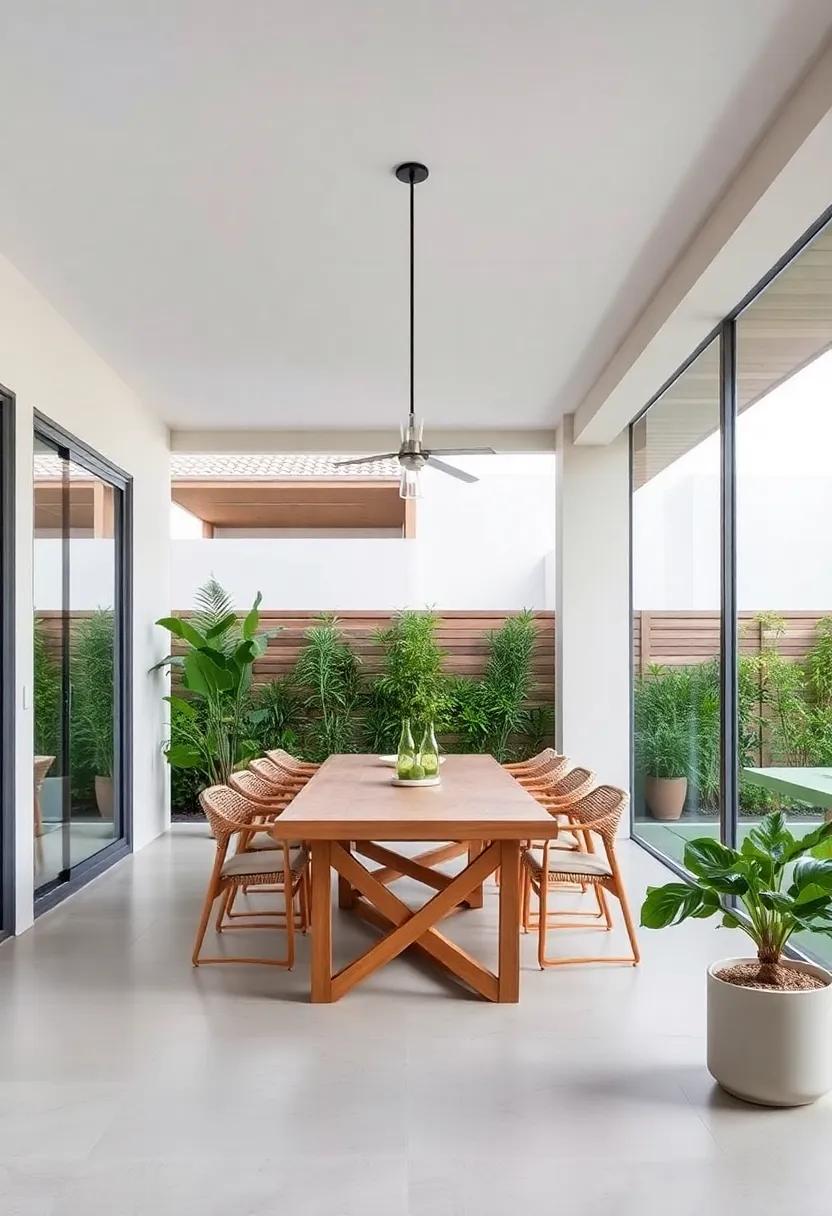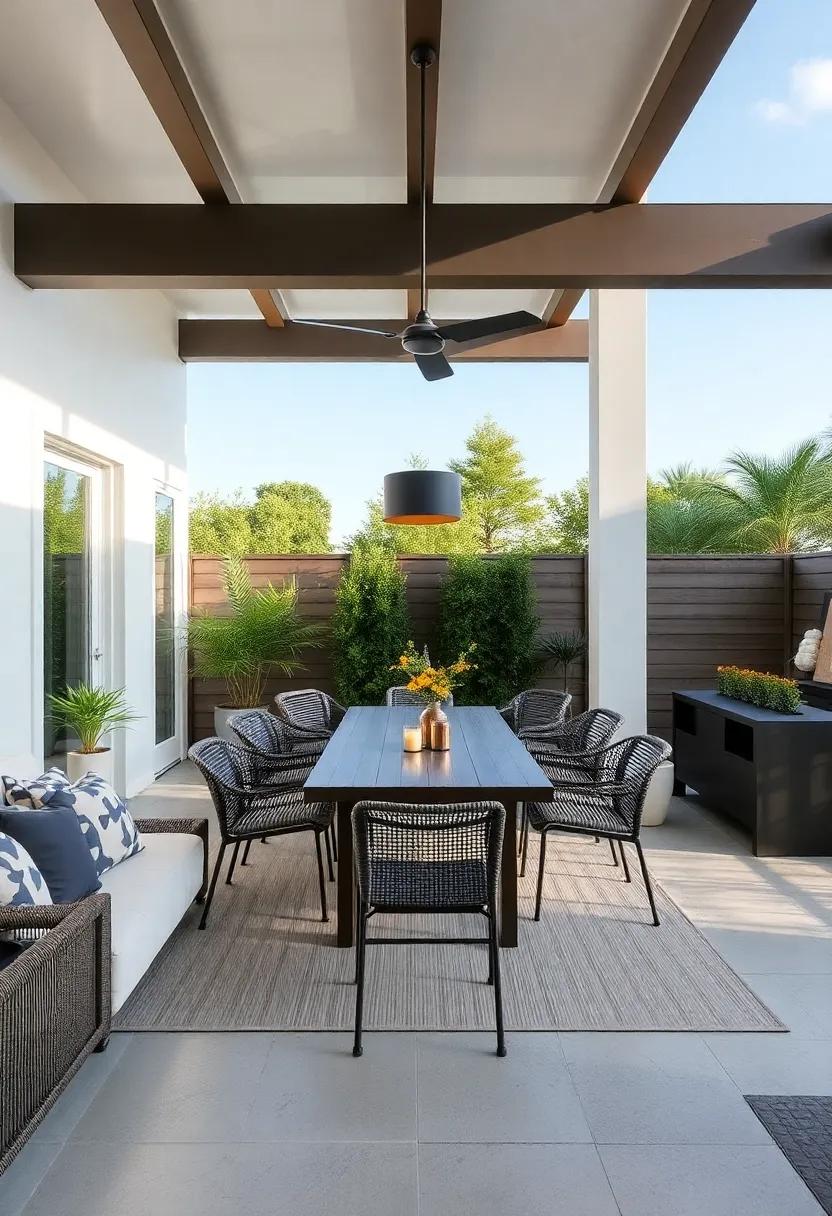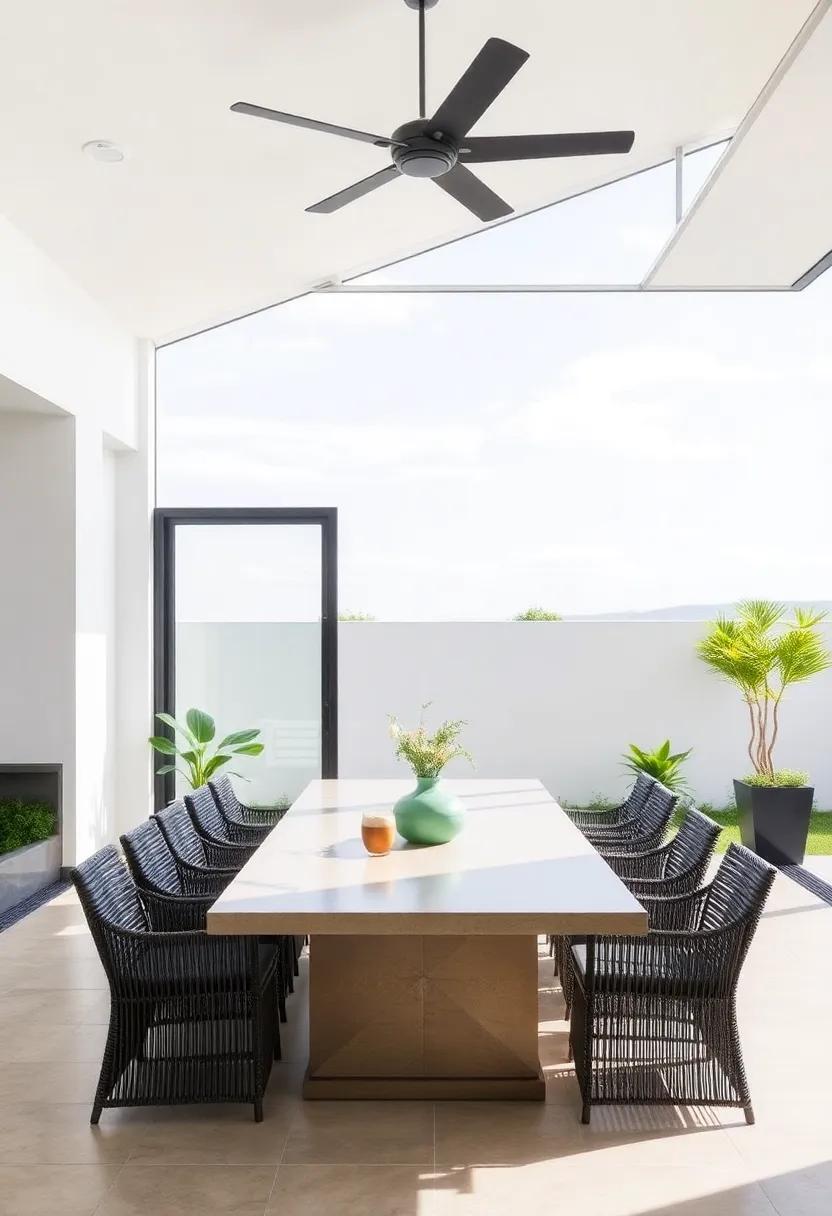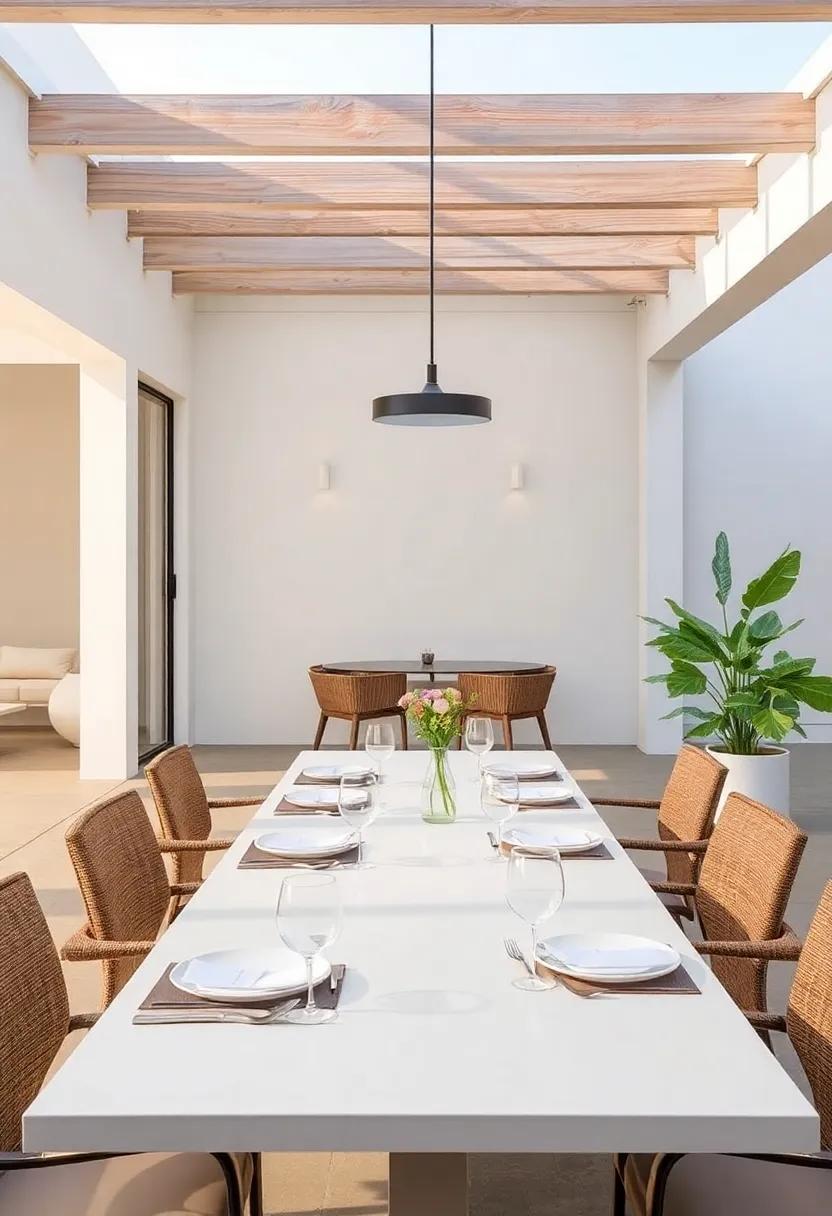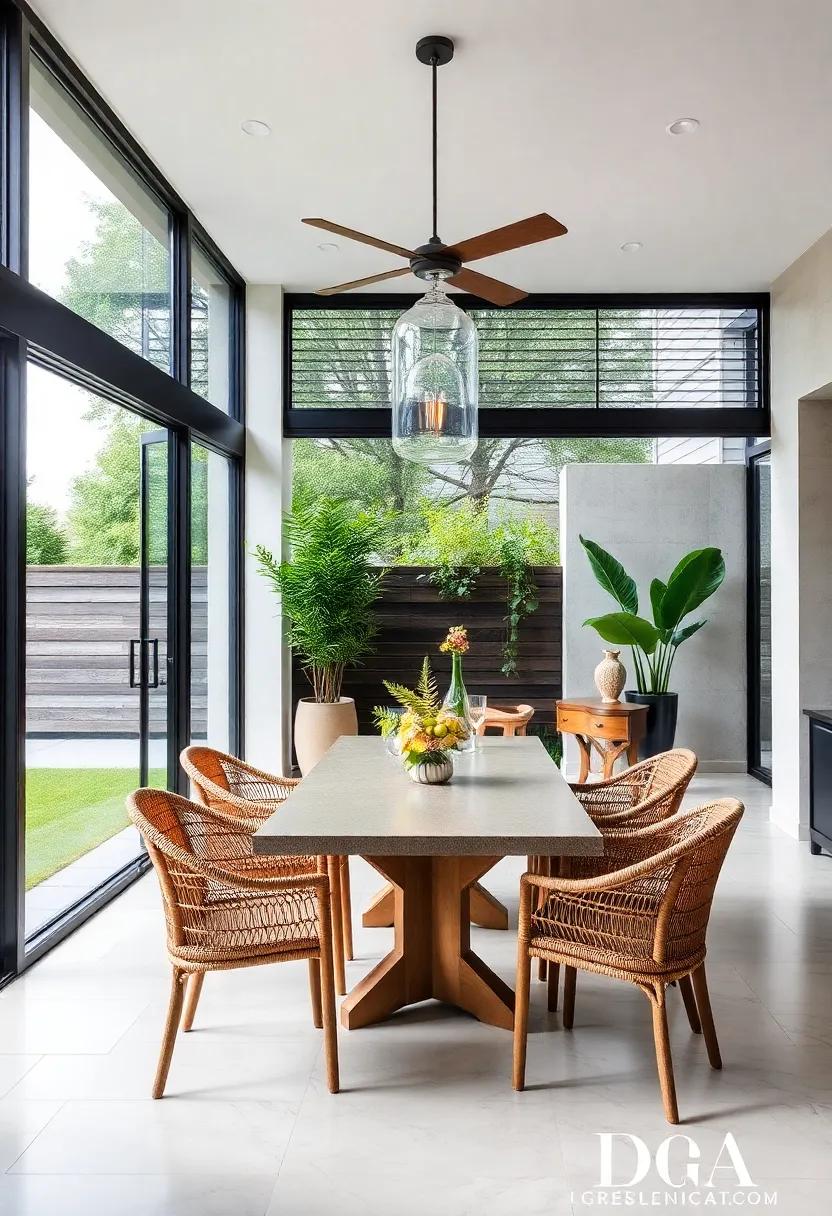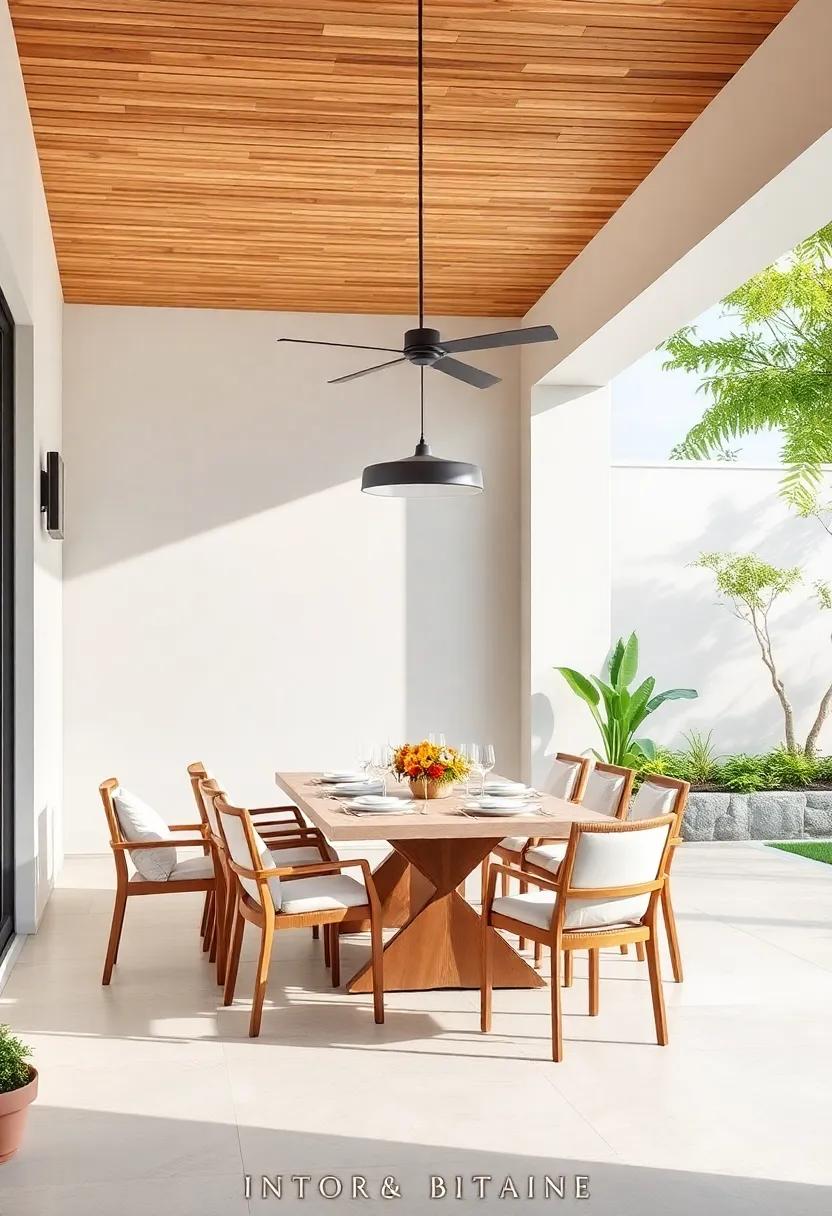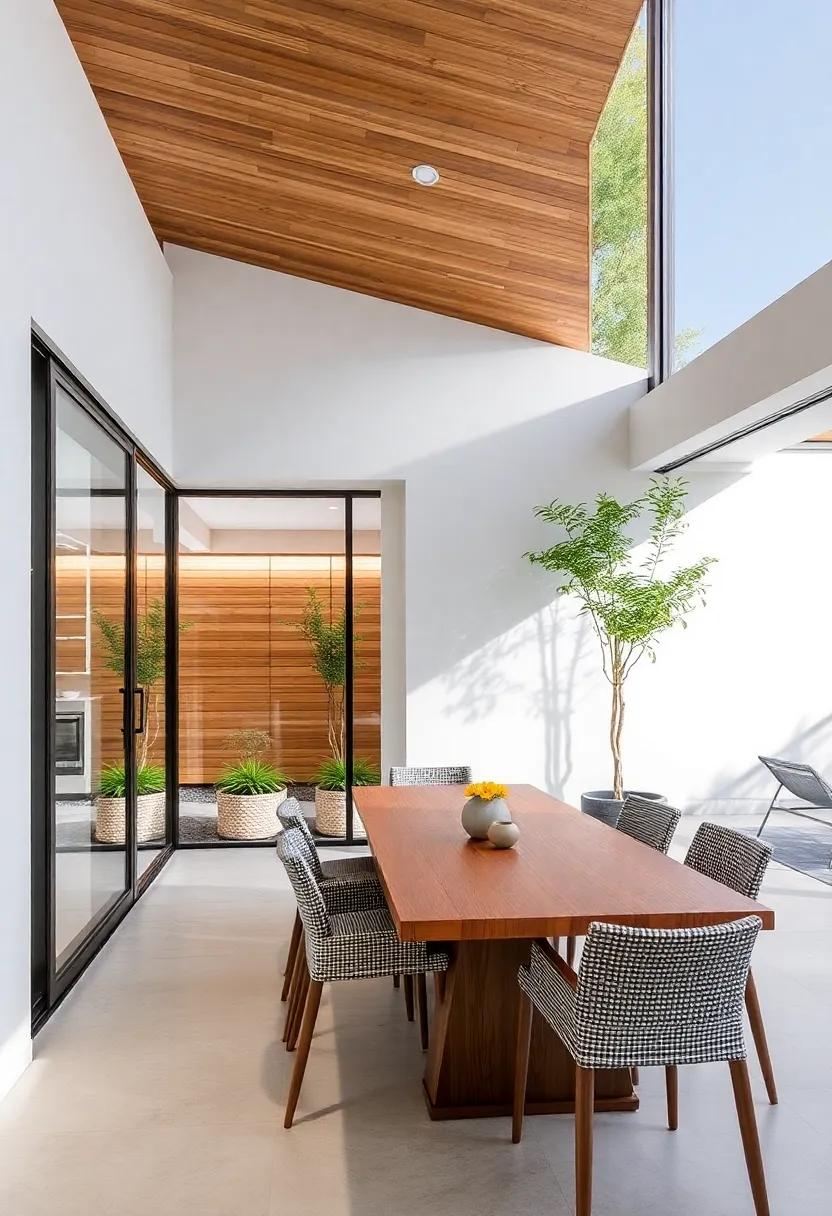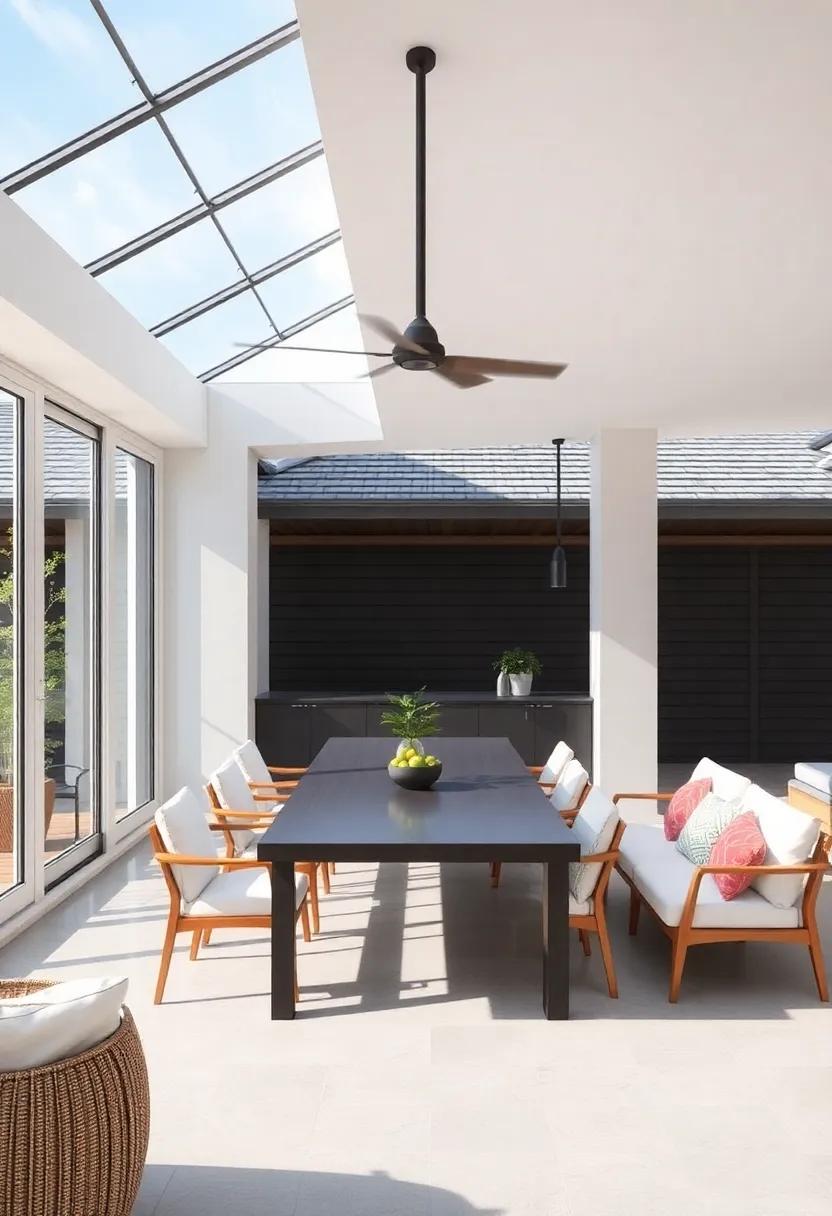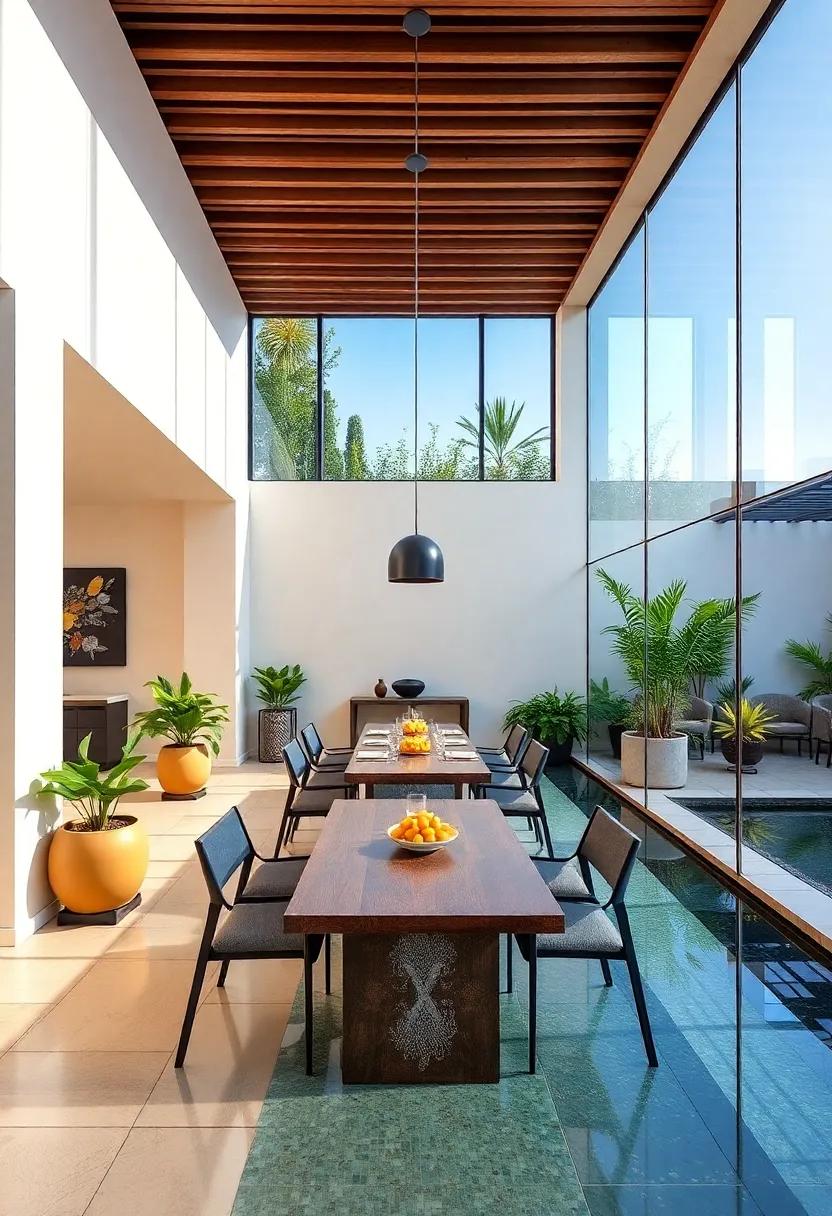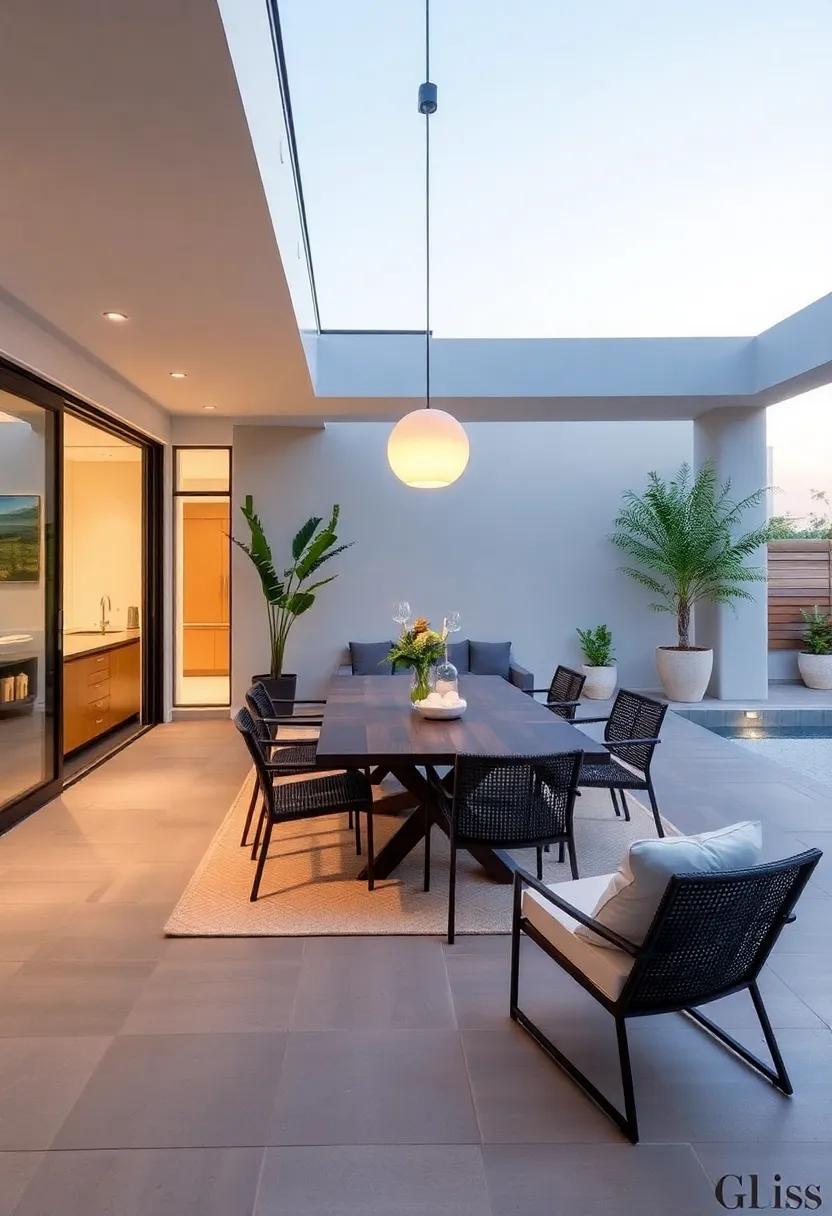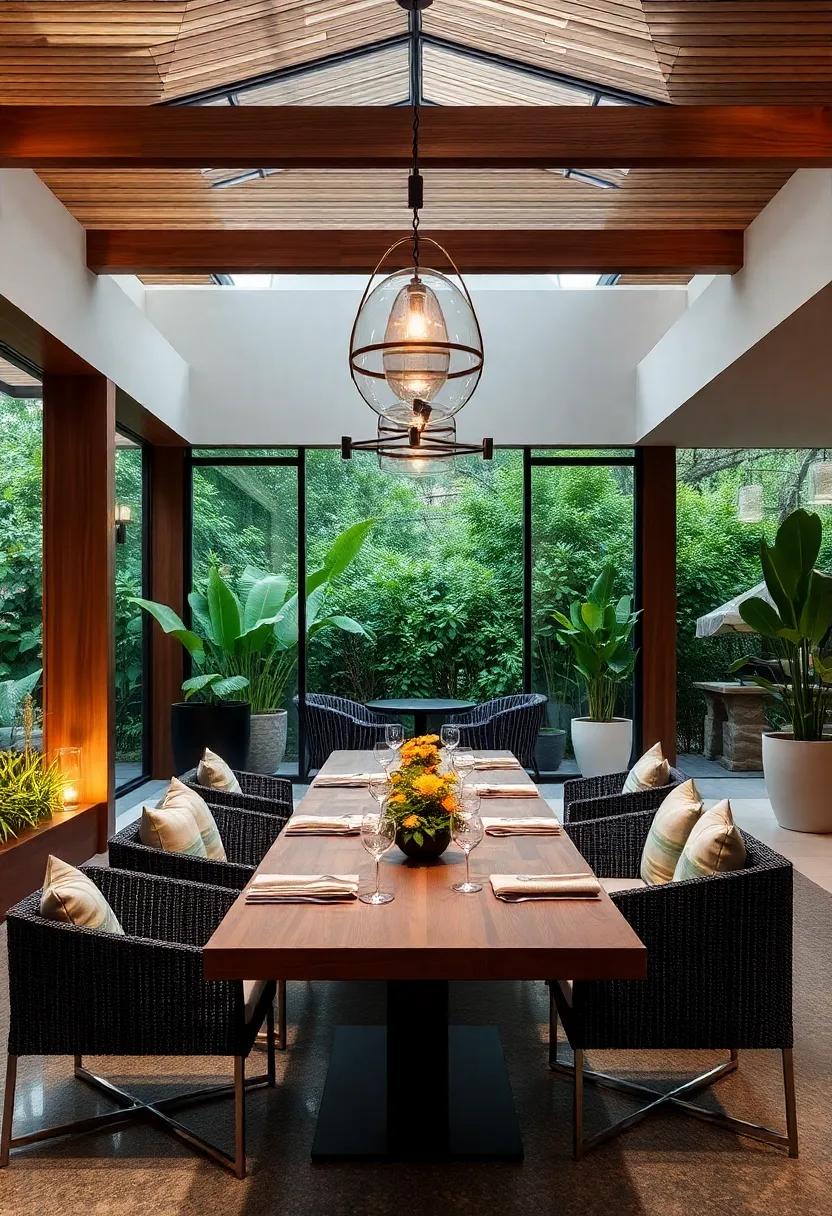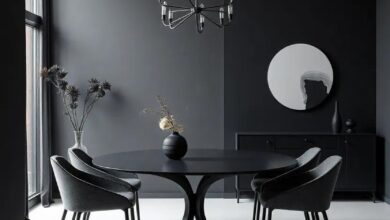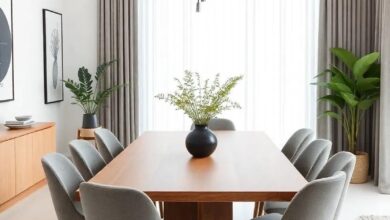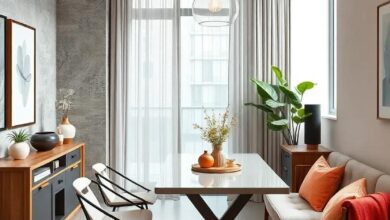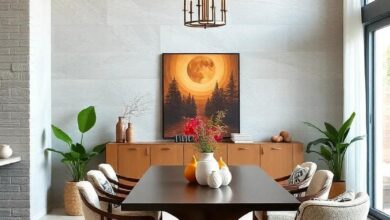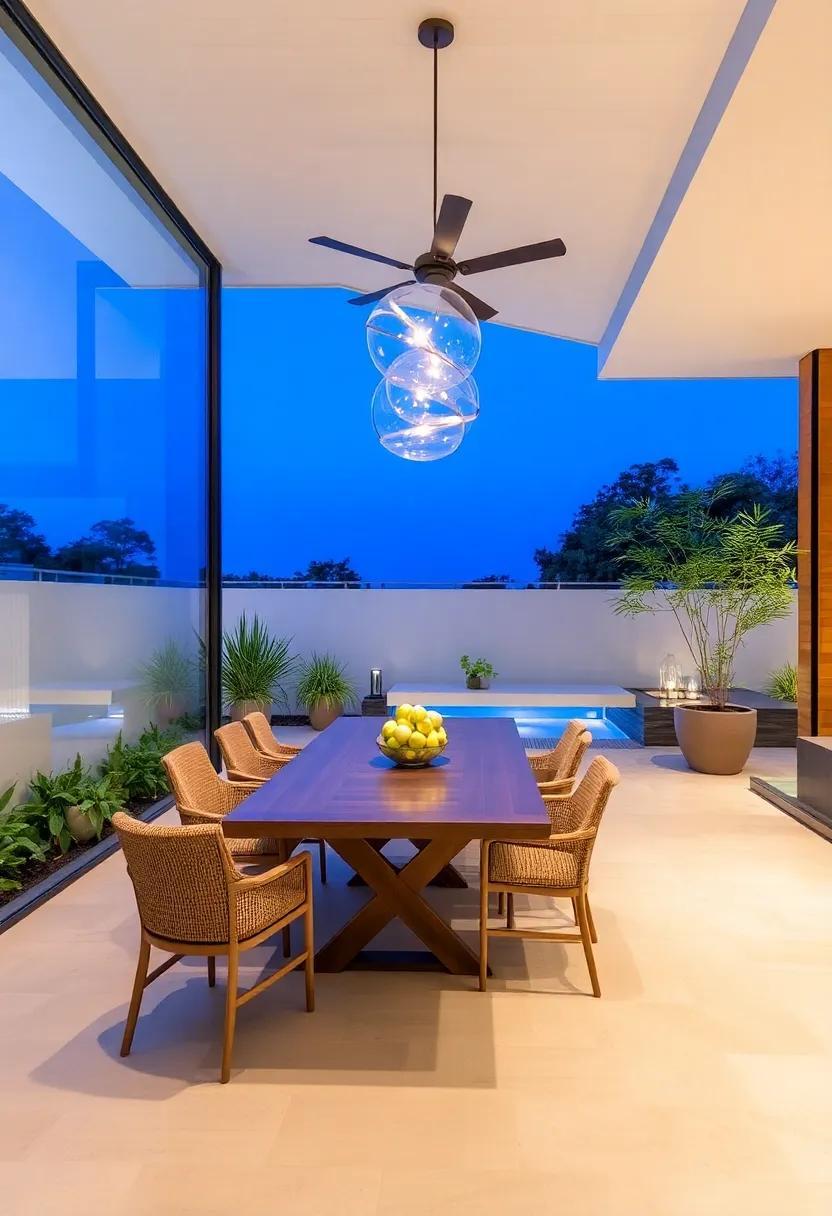
Transforming Spaces: Exploring Seamless Indoor-Outdoor Dining Room Transitions
In an era where our homes have become sanctuaries of comfort and creativity, the desire to blend indoor and outdoor living has taken center stage. The dining room, frequently enough regarded as the heart of the home, offers an ideal canvas for this harmonious fusion. “” invites readers to embark on a journey where the boundaries between the interior and exterior blur, allowing for an enriching dining experience that encompasses nature’s embrace. From sliding glass doors that invite the fresh air in, to thoughtfully designed furnishings that complement both spaces, we uncover innovative ideas and practical insights that elevate mealtime rituals. Join us as we explore the myriad ways to create dining environments that celebrate the beauty of both worlds, transforming how we gather, celebrate, and connect with loved ones.
Transforming Your Home with Open-Air Dining Experiences
Imagine savoring a fresh summer salad while surrounded by the gentle breeze and the warm glow of the setting sun. Open-air dining experiences allow homeowners to enjoy meals in a tranquil environment, seamlessly blending the interiors with the picturesque views of nature. By incorporating features such as expansive sliding glass doors or bi-fold windows,you can create an inviting atmosphere where family and friends gather in harmony with the outside world. Consider enhancing this experience with elements like:
- Stylish outdoor furniture that complements your indoor decor
- Ambient lighting, including string lights or lanterns, for evening dining
- Plants and greenery to create a natural border between spaces
- Durable textiles that can withstand the elements while adding comfort
Moreover, the strategic use of colors and materials can further elevate the aesthetic appeal of your dining area. By selecting a color palette that reflects the earth tones found in your garden, the transition between indoors and outdoors becomes effortless. Utilizing enduring materials such as bamboo or reclaimed wood fosters an eco-friendly vibe that harmonizes with nature. To inspire your design, here’s a table showcasing popular outdoor dining themes:
| Theme | Key features |
|---|---|
| Modern Minimalist | Clean lines, monochromatic colors, and sleek furniture |
| Rustic Charm | Wooden tables, vintage decor, and soft textiles |
| Tropical Escape | Luminous colors, floral patterns, and lush greenery |
Capturing Nature’s Beauty in Your Dining Space
Bringing the essence of the great outdoors into your dining area can transform your meals into a delightful experience. By incorporating natural elements, you can create an ambiance that not only reflects the beauty of nature but also fosters a connection with it. Consider adding features such as large windows that open up to scenic views, allowing natural light to flood in. Use materials like wood, stone, and woven fabrics to infuse an organic feel. Moreover, incorporating live plants and floral centerpieces can enliven the space and bring a refreshing touch to your dining experience.
To further enhance the connection between your indoor and outdoor spaces, think about creating a seamless transition.This can be achieved by using similar color palettes and textures both inside and out. For example, a cohesive color scheme can unify your dining area with the patio or garden.Consider the following elements to bridge the gap:
- Sliding Glass doors: These can elegantly open the dining space to the outside.
- Outdoor Furniture: Select styles that complement your indoor decor for a harmonious look.
- Rugs: Extend your indoor rugs outside to create a unified area.
The Art of blending Indoor and Outdoor Aesthetics
Creating a harmonious connection between indoor and outdoor spaces emboldens the aesthetic appeal of dining areas while inviting nature’s beauty indoors. Consider implementing large glass doors that can slide open, blurring the line between inside and out. This effortless transition invites fresh air and natural light, fostering a serene dining atmosphere. To enhance this integration, you might incorporate elements such as:
- Natural Materials: Use wood, stone, and organic textiles to create a cohesive feel throughout both spaces.
- Color Schemes: choose a palette that echoes nature, such as earthy tones or vibrant garden hues, to connect your decor with the outside world.
- Plants: Incorporate greenery inside to mimic the outdoors,using planters,vertical gardens,or hanging plants to transform your dining experience.
Lighting plays a pivotal role in maintaining this connection, especially in the evenings when outdoor dining is prevalent. Utilize layers of lighting — from sleek pendant fixtures inside to twinkling string lights outside — to create an inviting ambiance. When considering furniture, opt for pleasant, weather-resistant pieces that echo indoor designs. This way, you don’t just dine; you revel in the joy of being enveloped by your surroundings. A simple comparison of furniture choices can help illustrate the seamless blend:
| Indoor Furniture | Outdoor Furniture |
|---|---|
| Chic upholstered dining chairs | Stylish wicker chairs with cushions |
| Solid wood dining table | Tempered glass top with aluminum legs |
| Elegant lighting fixtures | weatherproof lanterns and fairy lights |
Creating Flow: Designing Seamless Transitions Between Indoors and Outdoors
To achieve a harmonious blend between indoor and outdoor dining spaces, the choice of materials and design elements plays a crucial role. Consider using large sliding glass doors that seamlessly connect the two areas, allowing natural light to flood into the indoor space while providing unobstructed views of the outdoors. Using similar flooring both inside and outside can help unify the spaces, creating a continuous flow.Additionally, incorporating natural elements like plants and water features in both settings enhances this synergy and creates an inviting atmosphere for diners.
Lighting can also bridge the gap between indoors and outdoors,providing a cohesive ambiance as day transitions into night. Layered lighting fixtures, such as pendant lights indoors and string lights outdoors, can create an inviting setting for evening gatherings. Furthermore, creating a versatile dining setup with movable furniture allows for easy adjustments based on the occasion, making it simple to transition from an intimate indoor meal to a lively outdoor feast. By keeping these design principles in mind, you can cultivate a space that encourages relaxation and social interaction.
Choosing the Right Furniture for Versatile Dining Spaces
When curating furniture for dining spaces that serve dual purposes, it’s essential to consider both functionality and aesthetics. Opt for modular pieces that can be rearranged effortlessly, allowing you to adapt the space for intimate gatherings or larger dinner parties. Look for dining tables that extend or those with interchangeable components. Choosing stackable chairs not only saves space but also enhances mobility, making it easy to transition from indoor to outdoor settings. Additionally, materials play a crucial role; select weather-resistant materials for outdoor use, ensuring they blend seamlessly with your indoor decor while providing durability.
Incorporating versatile storage solutions into your dining area can elevate its functionality.Utilize credenzas or sideboards that offer both display and storage options,helping you keep essentials like tableware or linens organized yet accessible. Here’s a rapid overview of materials and their recommended usage:
| Material | Best For |
|---|---|
| Teak | Outdoor tables and chairs |
| Metal | modern dining sets |
| Rattan | Lightweight furniture |
| Wood | Classic dining tables |
By thoughtfully selecting furniture that adapts to varying occasions, you can create a dynamic dining environment that harmoniously transitions between indoor and outdoor settings, making every meal an experience worth cherishing.
Maximizing Light: Embracing Windows and Doors in Design
Natural light is one of the moast transformative elements in home design, and strategically placed windows and doors can truly elevate the ambiance of a dining area.By maximizing light, homeowners not only enhance the aesthetic appeal but also create an inviting atmosphere that encourages gatherings and shared meals. Consider floor-to-ceiling windows or sliding glass doors that connect your dining room to an outdoor space. This seamless transition blurs the lines between indoor comfort and outdoor beauty, allowing diners to enjoy the sights and sounds of nature while remaining sheltered from the elements. Key features to contemplate include:
- Wide openings that encourage airflow and accessibility.
- Transom windows above doors for additional light without sacrificing privacy.
- Colored or patterned glass that adds artistic flair while filtering sunlight.
To further enhance the connection between the indoor and outdoor environments, consider integrating elements that reflect both spaces harmoniously. Shades of green and natural materials can be used in decor to echo the landscape, while warm tones in furniture can radiate a cozy feel. A well-thoght-out lighting plan that incorporates features such as pendant lights or wall sconces can ensure the dining area remains bright and inviting, nonetheless of the time of day. Below is a simple comparison of design elements that can be adopted to integrate indoor and outdoor dining:
| Element | Indoor Use | Outdoor Use |
|---|---|---|
| Materials | Wood, Fabric | Stone, Metal |
| Color Palette | Warm Neutrals | Earthy Greens |
| Seating | Comfortable Chairs | Weather-resistant Furniture |
Seasonal Decor that bridges Inside and Outside Ambiance
Embracing the changing seasons can rejuvenate the ambiance of your dining area, creating a harmonious flow between the indoors and outdoors. Utilize nature as your guide by incorporating elements that reflect the current season. For spring,think fresh flowers,light linens,and pastel colors that can effortlessly transition from the dining table to the garden table. In fall, opt for earthy tones and textured fabrics, augmented by seasonal accents like small pumpkins or vibrant leaves. Each element pulls in the charm of the outdoors, crafting an inviting atmosphere that encourages dining to become a sensory experience.
Elevating the aesthetic can also be achieved through a thoughtful selection of decor pieces that fit both environments. Consider using dining ware that blends seamlessly with the outdoor elements.Such as, choose dishes with natural motifs or subtle botanical prints. To create a cohesive look, layering is key; combine textures with woven placemats and handcrafted cutlery that invite guests to linger. integrating ambient lighting, such as string lights or lanterns, can definitely help illuminate the pathway between dining spaces, offering warmth regardless of where the meal takes place. Here’s a quick reference guide for seasonal décor:
| Season | Decor Ideas |
|---|---|
| Spring |
|
| Summer |
|
| Fall |
|
| Winter |
|
Innovative Lighting Solutions to Enhance Indoor-Outdoor Dining
Creating a harmonious transition between indoor and outdoor dining spaces requires thoughtful and innovative lighting solutions that not only enhance aesthetics but also define functionality. Unique fixtures can transform ordinary spaces into magical experiences,setting the mood for lively gatherings or intimate dinners. Consider options such as:
- String Lights: Drape them across patios or hanging from trees to provide a whimsical touch.
- Wall Sconces: Install these to illuminate walls and create depth, allowing walls to “speak” even when the sun sets.
- Seasonal Lanterns: Utilize themed lanterns for various occasions, adding seasonal charm.
- Table Centerpieces: Candle-lit centerpieces serve a dual purpose, offering ambiance while highlighting the dining experience.
In addition to decorative lighting, integrating smart technology can further enhance the dining experience. Controllable lighting systems allow users to adjust brightness and color to suit specific occasions. For example,a cozy evening meal might call for soft,warm hues,while a lively brunch could thrive under brighter,inviting shades. An integrated table comparison demonstrates the advantages of diffrent lighting setups:
| Lighting Type | Best For | Features |
|---|---|---|
| Ambient Lighting | Casual Gatherings | Soft, diffused light |
| task Lighting | Cooking or Dining | Focused light on work areas |
| Accent Lighting | Highlight Décor | creates visual interest |
The Role of Plants in Unifying Indoor and Outdoor Environments
Plants serve as the perfect bridge between indoor and outdoor spaces, creating a harmonious flow that enhances the dining experience. Incorporating greenery into your dining room not only beautifies the space but also blurs the lines between interior and exterior environments. By strategically placing plants, such as fiddle leaf figs or string of pearls, you can create a natural transition that invites the outdoors in. The tactile elements of foliage and the vibrant colors of blooms draw the eye outside, enriching the atmosphere and making every meal feel like an al fresco affair.
Moreover,the benefits of integrating plants extend beyond aesthetics. They improve air quality, add moisture, and create a more serene environment, all essential for a fulfilling dining experience. To effectively enhance your indoor-outdoor connection, consider the following:
- Choose native plants: These are often more resilient and suit local climates.
- Utilize planters: Elevated or hanging planters can create layered heights and visual interest.
- Flexible layouts: use furniture arrangements that allow easy movement between spaces.
- Natural materials: Incorporate wood or stone elements to reflect the outdoor environment.
To illustrate the perfect plant pairings for this concept, consider the following table:
| Plant type | Ideal Location | Benefits |
|---|---|---|
| Fiddle Leaf Fig | Near windows | Air purification, provides height |
| Pothos | Hanging baskets | Trailing beauty, easy care |
| Herbs (like Basil or Mint) | Dining table centerpieces | Fresh aroma, culinary use |
| lavender | Threshold between spaces | Relaxing scent, attracts pollinators |
Color Coordination: Harmonizing Your Living Spaces with Nature
Creating a harmonious living space often means embracing the colors found in nature. When designing dining rooms that extend seamlessly into the outdoors, consider integrating elements that reflect the surrounding environment. Use a color palette inspired by natural shades such as greens, browns, and soft earth tones to evoke tranquility and connection to the outdoors. Incorporating materials like wood,stone,and organic textiles can further enhance this theme,creating a cohesive flow from indoor to outdoor spaces. additionally, the strategic use of plants and botanical prints can infuse a lively touch, bringing vibrancy and warmth to the interior.
To achieve a well-coordinated look, consider these tips:
- Select a base color from your garden or landscape that can be reflected in your dining room décor.
- Incorporate various shades of the same hue for depth and interest.
- Utilize natural lighting to influence the color perception throughout different times of the day.
- Mix textures to create a layered aesthetic that feels inviting.
| Color Palette | Suggested Materials | Accent Items |
|---|---|---|
| Soft Green | Wood, Linen | Succulent Plants, Woven Baskets |
| Earth Brown | Stone, Cotton | Terracotta Pots, Natural Fiber Tablecloths |
| Sandy beige | Rattan, Jute | Glass Vases, Decorative Rocks |
Textures and Materials: A Recipe for Cohesive Design
In the quest for a seamless indoor-outdoor dining experience, the careful selection of textures and materials plays a pivotal role. By blending elements that evoke a sense of harmony, you can create a cohesive aesthetic that bridges the transition between spaces. Consider integrating natural textures such as wood and stone, which can establish a warm, inviting atmosphere. Pair these with soft fabrics like linen or cotton for seating arrangements, enhancing comfort while maintaining a stylish look.
to further elevate the design, think about the color palette and its relationship to the surrounding environment. Utilizing a harmonious mix of earthy tones and soft neutrals can foster a serene ambiance, making the area feel expansive and connected to nature. incorporating elements such as glass accents or metal finishes can serve as a bridge,reflecting light and nature while maintaining a elegant edge. A selection of plants can also soften the transition, using green hues to seamlessly tie the indoors with the outdoor landscape.
| Material | Texture | Purpose |
|---|---|---|
| Wood | warm, natural | Creates inviting spaces |
| Stone | Textured, robust | Provides stability and connection |
| Linen | Soft, breathable | Enhances comfort |
| Glass | Clear, reflective | Brings light and clarity |
Outdoor Elements to Enhance Indoor Dining Experiences
Creating an inviting atmosphere for indoor dining can be seamlessly achieved by incorporating outdoor elements. Natural light is an essential factor; wide-opening glass doors or large windows can flood your dining area with sunshine, bridging the gap between nature and comfort. Consider using indoor plants to bring in a touch of greenery, creating a vibrant and refreshing ambiance. Additionally,outdoor furniture styles,such as wicker or teak,can be introduced inside for a rustic yet sophisticated feel.
To further enhance the outdoor experience,think of textural contrasts.Incorporating materials like stone, wood, and metal into your decor can create a harmonious blend reminiscent of al fresco dining. Consider implementing outside-inspired decor, like lanterns or fairy lights, to evoke a sense of warmth and coziness during evening meals. Remember that sensory elements, such as soft sounds of nature or the faint scent of jasmine, can be replicated indoors through design choices and multi-sensory experiences.
functional Fleeting Spaces: The Magic of Multi-Use Areas
The concept of functional fleeting spaces redefines how we perceive indoor and outdoor areas, notably in the realm of dining. By skillfully blending elements from both realms, homeowners can create multifunctional environments that adapt to their needs.Imagine a cozy dining nook that seamlessly transforms into an al fresco setting with the mere flick of a door. This fluidity allows for various dining experiences, catering to intimate family dinners and vibrant gatherings alike. The key features of these dynamic spaces often include:
- Natural light: Expansive windows or glass doors invite the outside in, creating a bright, inviting atmosphere.
- Versatile Furniture: Lightweight, modular pieces enable quick reconfiguration for different occasions.
- Durable Materials: Weather-resistant surfaces ensure longevity, making transitions between indoors and outdoors even smoother.
incorporating nature into these spaces enhances not just aesthetics, but also well-being. Integrating greenery through indoor plants or outdoor patio gardens can create a sense of tranquility and connection to the environment.Here’s a quick look at some elements that facilitate this seamless blending:
| Element | Benefit |
|---|---|
| Sliding Glass Doors | Maximize openness, enhancing air circulation and views. |
| Area Rugs | Define zones while maintaining comfort and familiarity. |
| Outdoor-Grade Lighting | Create ambiance that extends the dining experience into the night. |
Weather-Resistant Furnishings for Year-Round Enjoyment
When curating your indoor-outdoor dining experience, incorporate weather-resistant furnishings that withstand the elements while elevating style. These pieces are engineered to endure various weather conditions, ensuring comfort and longevity.consider materials such as:
- Aluminum: Lightweight and rust-resistant, ideal for a modern touch.
- Teak: Naturally resilient to moisture and insects, adding a classic appeal.
- Resin wicker: A stylish and durable option that mimics natural fibers.
- Powder-coated steel: Provides durability and an array of colors to choose from.
To create an inviting atmosphere,select furnishings that not only withstand the weather but also harmonize with your surroundings. Look for designs that can easily transition from indoor elegance to outdoor charm. An effective strategy is to utilize versatile pieces that serve multiple functions:
| Furniture Type | indoor Use | outdoor Use |
|---|---|---|
| Extendable Dining Tables | Family gatherings | Outdoor barbecues |
| Stackable Chairs | Daily dining | patio lounging |
| Storage Benches | Entryway seating | Garden accessory storage |
Creating Privacy without Compromising Views
In the pursuit of creating intimate dining experiences while still enjoying the beauty of the outdoors, innovative design solutions have become essential. Translucent privacy screens, such as frosted glass panels and natural bamboo dividers, offer a stunning way to maintain visibility to your surroundings while providing a buffer from prying eyes. These screens not only delineate spaces but also enhance the aesthetic of your dining room, connecting seamlessly with nature. Incorporating plants around these areas can add a lush element, enhancing the atmosphere while elevating your sense of privacy.
Another integral approach is the use of multi-functional furniture that can adapt to various needs. Options such as extendable dining tables or benches with integrated storage enable adaptability for gatherings,allowing the space to be transformed effortlessly while maintaining an intimate ambiance. Outdoor fabrics and weather-resistant materials also ensure that your furnishings withstand the elements without sacrificing comfort or style. By thoughtfully combining these elements, homeowners can achieve a harmonious blend of privacy and open-air enjoyment, ultimately redefining the dining experience.
Visual Vignettes: Designing Inviting Table Settings
Creating a captivating dining experience begins with the art of table setting. Each element plays a crucial role in establishing an inviting atmosphere, seamlessly blending elegance with comfort. Here are some key components to consider when arranging your table:
- Color Palette: Choose a harmonious blend of colors that reflects the mood you aim to create.
- Textiles: Use tablecloths,runners,and placemats to add texture and depth.
- Dinnerware: Select unique plates, glasses, and cutlery that speak to your personal style.
- Floral Arrangements: Fresh flowers add vibrancy and a pleasant scent, making the setting more inviting.
- Lighting: Use candles or soft lighting to enhance the ambiance, creating an intimate atmosphere.
Taking it a step further, consider the placement and spacing of each item on the table. An organized layout enhances visual appeal while ensuring guests feel comfortable. here’s a simple guide to help achieve this balance:
| element | Recommended Placement |
|---|---|
| Plates | Centered on each setting, about one inch from the table edge. |
| Cutlery | Positioned outside of plates, arranged from the outside in according to the order of use. |
| Glasses | Placed above the knife, slightly to the right of the plate for easy access. |
| Centerpieces | Should be low enough to encourage conversation, ideally no more than 12 inches in height. |
Art and Decor that Celebrate the Great Outdoors
To create a dining room that pays homage to the beauty of the natural world, incorporating art and decor elements inspired by the outdoors is essential.Consider nature-inspired artworks such as landscape paintings, botanical prints, or even mixed-media pieces that utilize natural materials. These artistic expressions not only breathe life into your space but also create a sense of tranquility. additionally, choosing decor items that echo the textures and colors found in nature can reinforce this theme:
- Woven wall hangings in earthy tones
- Ceramic tableware that mimics the look of stone or clay
- Large indoor plants that connect the dining area with the outside
- Rattan or bamboo furniture for a warm, rustic feel
Incorporating elements such as natural light and outdoor views can further enhance the connection to nature. Explore the concept of using large glass doors or windows that seamlessly blend indoor and outdoor spaces. This design choice not only invites sunlight but also showcases the changing landscapes outside, making your dining experience ever more dynamic. To give the area a finished touch, consider adding a few decorative pieces like:
| Decor Item | Purpose |
|---|---|
| Outdoor lanterns | Enhances evening ambiance |
| Wildflower arrangements | Adds freshness and color |
| natural fiber table runners | Brings texture and warmth |
Crafting an Inviting Atmosphere for Al Fresco Dining
To create an enchanting al fresco dining experience,focus on layering textures and introducing elements that stimulate the senses. Start by choosing comfortable seating that encourages lingering—think plush cushions and woven chairs that invite guests to settle in. Incorporate natural materials like wood and stone to harmonize with the outdoor setting, enhancing that rustic charm. Ambient lighting plays a crucial role; string lights or lanterns can cast a warm glow, transforming your patio or garden into a captivating oasis.Don’t forget the power of greenery: potted plants,hanging foliage,and floral centerpieces instill life and vibrancy into your dining space.
Additionally, consider practical elements that facilitate seamless transitions between indoor and outdoor dining.A well-placed outdoor bar cart or a dedicated beverage station can elevate the experience, allowing guests to serve themselves without constant back-and-forth trips. using a cohesive color palette for table settings and décor also helps unify the spaces; opt for soft hues that reflect the surrounding nature. To aid in planning the layout, here’s a simple table to visualize your setup:
| Element | Purpose | Suggested Styles |
|---|---|---|
| Seating | Comfort and relaxation | Woven, cushioned, or wooden |
| Lighting | Create ambiance | String lights, candles, lanterns |
| Greenery | Enhance visual appeal | Potted plants, hanging vines |
| Color Palette | Unify space | Natural, soft tones |
Emphasizing Flow: Paths and Patterns in Design
In an age where functionality meets aesthetic appeal, the transition between indoor and outdoor spaces has become a focal point in modern design. Thoughtfully curated flow enhances not only the visual continuity but also the experience of dining.Consider elements such as:
- Natural Lighting: Large glass doors that open wide create an inviting invitation to the outdoors.
- Materials: Use similar materials for both interiors and exteriors to blur the lines, like hardwood floors or stone pathways.
- Color Palette: A cohesive color scheme linking both areas can enhance the sense of harmony.
Paths that guide the eye and foot traffic ensure that the experience of dining flows seamlessly. By integrating design features that encourage movement between spaces, such as:
| Design Element | Impact |
|---|---|
| outdoor Patios | Extends living space, inviting al fresco dining. |
| Sliding Glass Panels | Simplifies the transition, enhancing accessibility. |
By combining these elements, spaces can be transformed into cohesive environments that encourage relaxation and enjoyment. Ultimately, a well-designed transition achieves more than mere aesthetics; it fosters a connection to nature, enriching the dining experience with the ever-changing backdrop of the outdoors.
Unleashing Creativity with Multi-purpose Dining Areas
In an age where versatility and functionality are key, the dining room has evolved into a dynamic space that caters to a variety of needs. Multi-purpose dining areas seamlessly blend functionality with style,allowing for a graceful shift from formal family dinners to lively gatherings with friends. here are some innovative ways to maximize your dining area:
- Flexible Furniture: Opt for tables that can extend or collapse, along with stackable or foldable chairs.
- Integrated Storage: Incorporate shelves or benches with hidden compartments to keep essentials organized and easily accessible.
- Smart Lighting: Use adjustable lighting to create the perfect ambiance, whether you’re hosting a casual brunch or an elegant dinner party.
Transitioning your dining area to embrace the outdoors can dramatically enhance the overall experience, inviting nature into your meals. Large sliding or bi-fold doors can create an open flow. Moreover, combining interior and exterior elements not only adds aesthetic value but also promotes a sense of continuity.Consider the following elements when creating your indoor-outdoor dining experience:
- Natural Materials: Utilize wood, stone, and metal to enhance the seamless synergy between indoor and outdoor spaces.
- Color Palette: Choose cohesive colors that mirror the natural beauty outside, providing a harmonious visual connection.
- Greenery: Incorporate potted plants or vertical gardens to blur the lines between indoor comfort and outdoor freshness.
Incorporating Water features into Dining Zones
Integrating water features into dining areas can create a harmonious atmosphere that elevates outdoor and indoor dining experiences. The gentle sound of running water can transform a simple meal into a serene event, adding a soothing auditory backdrop that encourages relaxation and conversation. Whether it’s a small fountain or a larger pond, these elements serve as stunning focal points. Consider the following options for incorporating water features into your dining spaces:
- Water Walls: Vertical installations that can be integrated into the wall design, adding texture and visual intrigue.
- Tabletop fountains: Ideal for smaller spaces, these portable features enhance ambiance without overwhelming.
- Ponds or Reflecting Pools: For more expansive areas, these can be strategically placed to draw guests’ eyes while providing a tranquil setting.
Beyond aesthetics, water features also play a functional role in regulating temperatures and improving humidity levels, making dining environments more comfortable year-round. The strategic placement of seating around these features can enhance the overall dining experience, encouraging guests to linger. Consider how the layout can maximize visibility and interaction with the water:
| Feature Type | Benefits |
|---|---|
| Fountains | Creates a calming sound and picturesque focal point. |
| Pools | Provides a refreshing area for outdoor dining during warm months. |
| Creeks | enhances landscape aesthetics while promoting biodiversity. |
Building Comfort: Enhancing Indoor Outdoor Ambiance
creating a harmonious indoor-outdoor ambiance requires thoughtful design elements that seamlessly blend the two areas. Natural materials play a pivotal role in bridging the indoor space with the outdoors, as they evoke a sense of tranquility and comfort. Incorporating features such as bamboo flooring or reclaimed wood beams can create a warm and inviting atmosphere. Additionally,the use of large sliding doors or bi-folding windows can enhance the flow between spaces,allowing for uninterrupted views and easy access to the fresh air and natural light. A well-designed color palette, using neutral tones mixed with vibrant outdoor hues, can visually tie the spaces together, ensuring they feel cohesive and aesthetically pleasing.
To optimize the indoor-outdoor experience, consider integrating elements that cater to the senses. Incorporating outdoor rugs and cushions can make the intermittent spaces feel cozier, while strategically placed planters can bring a pop of greenery to both realms. Adding ambient lighting throughout, such as string lights or lanterns, enhances evening gatherings, making them memorable and inviting. To summarize, a prosperous transition between indoor and outdoor dining areas can be achieved by addressing key design elements:
| Design Element | Benefit |
|---|---|
| Natural Materials | Adds warmth and texture |
| Large Openings | Enhances airflow and views |
| Cozy Accessories | Creates comfort and intimacy |
| Ambient Lighting | sets mood for gatherings |
Exploring Innovative Roof Solutions for Year-Round Enjoyment
In the dynamic world of design, innovative roofing options are transforming how we experience our living spaces. Homeowners are beginning to appreciate roofs as an extension of their indoor environments, allowing for seamless transitions that enhance year-round enjoyment. Consider structures that incorporate glass elements or retractable canopies, which not only provide shelter but also open up to the sky, creating a unique atmosphere. These modern solutions blend functionality with aesthetics,enabling homeowners to customize their outdoor spaces to suit changing weather conditions while maintaining the beauty of the landscape.
Additionally, integrating green roofs with native vegetation offers a sustainable approach that benefits both the environment and the dwelling’s energy efficiency. The possibilities are endless, from pergolas featuring integrated stormwater management systems to solar panels that provide renewable energy, ensuring your roof does more than simply cover your home. Here are some key attributes to consider when exploring innovative roof solutions:
- Versatility: Adaptable designs for any season
- Durability: Materials that withstand various weather conditions
- Aesthetics: Options that complement the overall design of your home
- Sustainability: Eco-friendly features that reduce environmental impact
Celebrating culinary Experiences with Nature as the backdrop
Embracing the great outdoors while you dine elevates meal experiences to new heights.Picture yourself savoring a delightful gourmet dish, the warm breeze caressing your skin, and the vibrant hues of flowers and greenery surrounding you. This harmonious blend of natural beauty and culinary artistry creates an atmosphere that nurtures both body and spirit. It’s an invitation to immerse in the flavors of seasonal ingredients, where each bite resonates with the fresh essence of nature. In these moments,not only do you feed the body,but you also nourish the soul.
To seamlessly bring the outside in, consider elements that enhance this connection between your indoor and outdoor dining spaces. Translucent folding doors offer a fluid transition while flooding your indoor area with natural light. Additionally, incorporating natural materials like wood and stone can bring warmth and continuity.Here’s a brief look at essential elements for creating that perfect indoor-outdoor dining ambiance:
| Element | Description |
|---|---|
| Light Fixtures | Add soft, ambient lighting to enhance the natural glow of your surroundings. |
| Textiles | Choose weather-resistant fabrics for cushions and table linens that complement your outdoor environment. |
| Landscaping | Design a lush garden that can be enjoyed from both inside and outside, integrating native plants. |
Incorporating these elements will not only simplify the transitional flow between your dining areas but will also inspire unique culinary experiences that celebrate nature. Imagine hosting gatherings where friends and family can indulge in feasts under the stars or brunches kissed by sunlight. with the right design choices, every meal can become a cherished occasion, seamlessly intertwining sophistication and the beauty of the natural world.
The Conclusion
As we draw the curtains on our exploration of seamless indoor-outdoor dining room transitions, it becomes clear that the boundaries between our living spaces and the natural world are not merely physical—they are an invitation to a richer, more vibrant lifestyle. By embracing elements that enhance both beauty and functionality,we can create dining environments that celebrate the changing seasons and the everyday moments shared with family and friends.
from biophilic design that brings nature’s serenity indoors to sliding glass doors that dissolve conventional barriers, the possibilities are as diverse as our personal tastes. Whether you yearn for sunlit breakfasts surrounded by blooming flora or cozy dinners under a starlit sky, the art of transforming spaces invigorates our culinary experiences and nurtures our spirits.
As we embark on our own journeys of transformation, let us remember that every choice we make—every color, texture, and layout—contributes to a larger narrative of connection, sustainability, and joy. So, as you ponder the potential of your dining spaces, consider this: the true beauty of life is best savored when shared, and the perfect setting can turn a meal into a cherished memory.With a thoughtful approach, your indoor-outdoor space can become not just a dining area, but a living testament to the harmony of nature and nurture, inviting you to gather, indulge, and celebrate in every season.
As an Amazon Associate I earn from qualifying purchases.
